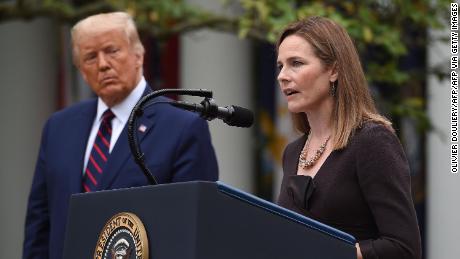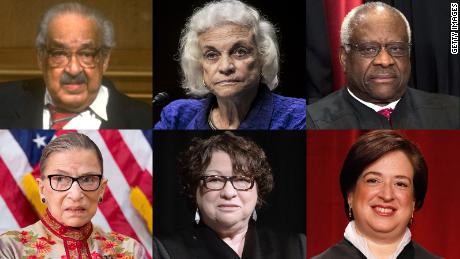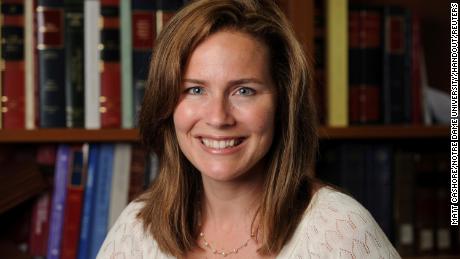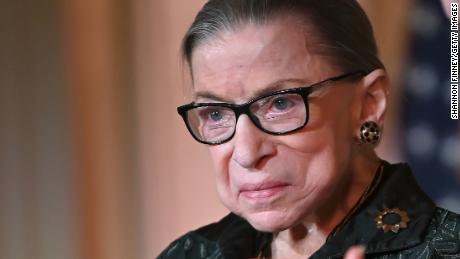How Trump picked Amy Coney Barrett over Barbara Lagoa
Egged on by members of his political team and allies in the state, Trump appeared captivated in conversations last weekend by the prospect of nominating a woman whose biography — daughter of Cuban exiles with roots in a community that could prove critical to his re-election — so obviously aligned with his political prerogatives.
Yet within a day or so, Trump’s newfound excitement for Lagoa had diminished so dramatically that she never received a formal sit-down with the President — her chances dashed by the intersection of an impossibly fraught timeline that left little room for error, intense pressure from some of his advisers to make a safe selection and a religious right galvanized by Barrett, the woman Trump ultimately selected for the seat.
“I looked and I studied, and you are very eminently qualified for this job,” Trump told Barrett in the Rose Garden on Saturday. “You are going to be fantastic.”
This account is based on interviews with nearly a dozen sources, including White House officials, conservative allies and people close to the process, many who spoke on the condition of anonymity to speak frankly about Trump’s selection process. Coming two months before an election that polls currently show him losing, this year’s Supreme Court vacancy has the potential both to reshape that race and to significantly alter the ideological tilt of the high court for years.
Over the course of two days this week, Trump’s decision seemed cemented when he met with Barrett for hours at the White House, including lengthy one-on-one sessions without any aides present. Unlike their interview two years ago for an earlier Supreme Court vacancy, when officials walked away believing she had failed to impress a President drawn to big personalities with Ivy League degrees, this time Trump and Barrett appeared to gel personally, people who spoke to the President afterward said.
So convinced did Trump seem in his selection that aides scheduled no formal interviews with any other potential candidates — including Lagoa.
Still, the evening before announcing Barrett as his Supreme Court pick, Trump was continuing to poll his supporters during a fundraiser at his hotel in Washington about whom he should nominate to the vacant seat, according a person who heard Trump’s remarks. At least one suggested Lagoa.
“Let her know she’s going to have her chance,” Trump replied, the person said.
The narrow window for confirmation before the November 3 vote has allowed little room for error in a highly orchestrated nominee selection and rollout — and has already generated outcry from Trump’s opponents, who insist the seat should be filled by whomever wins this year’s election.
An eleventh-hour lifeline
The ferocity of emotion surrounding the vacancy was on vibrant display Thursday when Trump visited the court to pay respects to Ginsburg, who was lying in repose. Trump has appeared highly cognizant of Ginsburg’s legacy, and even instructed aides to set up the Rose Garden on Saturday in a fashion that mimicked Bill Clinton’s nomination announcement in 1993.
There was never much question Trump would put forward a nominee and that the GOP-held Senate would hold a vote, even though Republicans refused to consider President Barack Obama’s nominee to fill a Supreme Court vacancy in the months before the 2016 election.
Returning from northern Minnesota last Friday following news of Ginsburg’s death, Trump conferred in his onboard office with top aides, including Stephen Miller, Hope Hicks, Bill Stepien and Dan Scavino, about potential nominees and what each might mean for his political future.
As televisions set to Fox News reported on Ginsburg’s death, Trump helped approve a statement marking the death of the liberal icon and women’s rights champion. But he also began formulating a plan to replace her. Ninety minutes after the court announced Ginsburg’s death — and 40 minutes after Trump learned the news, which aides didn’t tell him while he was speaking at a campaign rally — McConnell said in a statement that Trump’s nominee would get a vote.
Passed over in 2018, Barrett had long been viewed as the likely choice should Ginsburg retire or pass away, a scenario White House aides began viewing as increasingly likely as her health deteriorated this spring and summer.
Though Trump recently released a list of names he would consider for the court, a more serious shortlist of candidates for Ginsburg’s seat had been circulating in the White House for months. Barrett had always been considered the top choice — particularly because Trump had led many of her allies to believe he wanted to nominate her to replace Ginsburg should she retire or pass away.
So when they learned last week that Lagoa’s name was circulating with a new ferocity, Barrett’s supporters became fearful the President’s mercurial tendency to swing wildly on personnel decisions could jeopardize not only their favorite pick but the ability to fill the seat before the November election. A campaign to ensure Barrett was the pick ensued in the coming days and culminated with the President never meeting another candidate in person.
For some of Trump’s aides and allies on Capitol Hill, the effort meant streamlining the process by attempting to circumvent Trump’s tendency to flood the zone with new names and block any media-fueled whiplash between candidates.
‘She’s Hispanic and highly respected’
Barrett was a favorite of several inside the White House, including White House Counsel Pat Cipollone and Vice President Mike Pence, who, like Barrett, has a close connection to Indiana. Chief of staff Mark Meadows initially advocated for Allison Jones Rushing, a 38-year-old judge who sits on the Fourth Circuit in North Carolina. Yet she was seen by most as too young, and Meadows quickly shifted his support to Barrett once it became clear others were uniting behind her.
Yet for a time, the President seemed smitten with the idea of nominating Lagoa — a prospect that Trump’s campaign advisers told him would prove smart politics as it was becoming clear Florida would again play an outsized role in the election. Lagoa and her supporters hoped a presidential interview was in the making and Trump was headed to an event with Latino supporters near the end of the week.
White House officials began making plans for the President to meet with Lagoa in person, but that idea was eventually scrapped as other officials began to coalesce around Barrett as the pick. Those backing Barrett feared if Trump met with other candidates, he could change his mind and possibly throw uncertainty into the mix — something they had little time for given the narrowing confirmation timeline.
Those pushing for Barrett also felt there were too many unknowns about Lagoa’s record. The bulk of her career has been spent on state courts and she had few big opinions on the constitutional issues that now circle the court, those people argued, concluding there was no time to flesh out her record, scour media accounts, speeches or early writings.
In public, Trump attempted to build suspense around his pick, praising Lagoa even though sources said he had cooled on her privately early on.
“She’s an extraordinary person,” he said last Saturday. “I’ve heard incredible things about her. I don’t know her. She’s Hispanic and highly respected in Miami. Highly respected.”
By then, questions had already begun to arise inside the White House about Lagoa’s ties to the Bush family, given Jeb Bush had put her on a state appellate court.
Decades later, conservatives are still stung that President George H.W. Bush squandered a coveted Supreme Court seat by placing David Souter, who was relatively unknown, on the bench. Souter went on to become a consistent liberal vote until he retired in 2009. Trump himself is also highly skeptical of the Bush family, who he has openly insulted as failed politicians, though George W. Bush did advocate for Kavanaugh during his confirmation battle in 2018.
Once Trump realized Lagoa’s ties to Jeb Bush — a former opponent he still privately complains about — he quickly reversed course. Those who had been advocating for her realized the chances of her selection were slim.
Though the process raised her national profile, the ultimate decision was a disappointment for Lagoa’s supporters, who believe she would have wowed the President had they met in person. She had already testified before Congress that she shared the same conservative judicial philosophy that was championed by the late Justice Antonin Scalia, revered by conservatives and frequently mentioned by Trump himself.
To supporters of Lagoa following along in the press, the veiled criticism of her was also disheartening. She had the support of conservative Gov. Ron DeSantis, a close Trump ally, and had twice been vetted for the lower courts.
A feminist icon of their own
With Lagoa apparently out of the running, a scramble began on Capitol Hill and inside the White House to execute a plan hatched earlier in Trump’s tenure that would see Ginsburg replaced by Barrett, her ideological opposite. Republicans like former White House counsel Don McGahn knew it would be critical to replace a feminist icon with one of their own, according to sources familiar with his thinking.
Barrett had invigorated and emboldened conservatives after her confirmation hearing for the Seventh Circuit. At the hearing, top-ranked Democratic member Sen. Dianne Feinstein had pressed her on her writing about faith and the law. In a tense exchange between Barrett and Feinstein, the Democratic senator sharply questioned whether the judicial nominee could separate her Catholic views from her legal opinions.
“The conclusion one draws is that the dogma lives loudly within you,” Feinstein pointedly said. “And that’s of concern when you come to big issues that large numbers of people have fought for years in this county.”
Before long there were T-shirts with the words “the dogma lives loudly” imprinted upon them.
Cipollone and Meadows took joint roles leading the selection process. One person who played less of a role this time around was Leonard Leo, the executive vice president of the Federalist Society who shaped Trump’s initial list of potential Supreme Court candidates. Leo was kept further from the process this time around for primarily two reasons, a source said: Trump blames him for advising him to hire former Deputy Attorney General Rod Rosenstein, and officials believed Leo took too much public credit for the last two Supreme Court picks.
As Trump went through his list before ultimately selecting Kavanaugh in 2018, he also met with Barrett, who had been vetted by White House attorneys as senators familiarized themselves with her record. Trump was not impressed by Barrett after meeting with her in 2018, officials familiar with the session said. Barrett, according to a source familiar with the matter, was also distracted by a contact lens issue.
But Trump’s opinion of Barrett changed after meeting with her for several hours in the Oval Office on Monday and Tuesday. Barrett also met separately with Cipollone and Pence. People who spoke to Trump afterward she he described her as “brilliant” and said he seemed taken with her personally.
By the time Barrett had returned to Indiana, Trump seemed settled in his choice, though publicly sought to extend the dramatics of his choice into the weekend by refusing to say whether he’d made his selection.
Barrett, meanwhile, appeared intent on grasping to the final glimmers of a normal life before what is expected to be a highly contentious confirmation battle that, if successful, will lead to a lifetime appointment as a Supreme Court justice.
On Friday, as word emerged in Washington that Trump had made his selection, Barrett was spotted piloting her Honda minivan into her driveway in South Bend, Indiana, climbing out with a reusable Whole Foods grocery bag and greeting two of her children with hugs.
CNN’s Jeremy Diamond contributed to this report.
![]()












